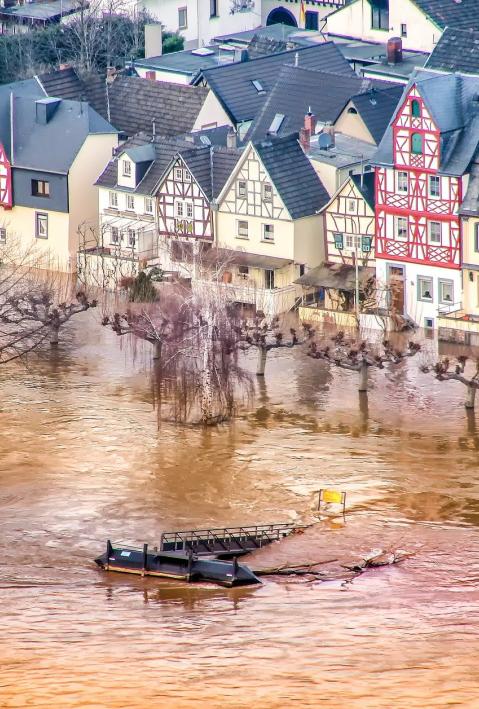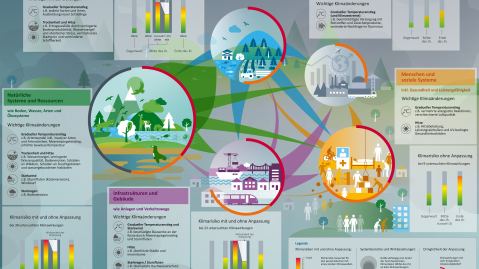
Shared pathways to net zero in Korea and Germany
News publ. 10. Dec 2025
Insight by Walter Kahlenborn

How will climate change affect the environment, our health, everyday lives and economy in Germany? Where can we reduce climate risks through adaptation? And where do we urgently need to do something?
On behalf of the Federal Environment Agency, adelphi explored these questions in a research consortium and summarised the results in the Climate Impact and Risk Assessment 2021 (KWRA). KWRA 2021 analyses the connections between the individual effects of climate change in Germany in a comprehensive, detailed manner. The study provides an extensive picture of climate risks and identifies adaptation measures.
The Intergovernmental Panel on Climate Change (IPCC) published the Sixth Assessment Report a few weeks ago. The over 200 participating authors compiled the latest scientific data on climate change and future emission scenarios. The report makes clear: we, human beings, are to blame for climate change. In all the emission scenarios, it is likely that the global average temperature will exceed 1.5 degrees compared to the pre-industrial level by 2030.
The Climate Impact and Risk Assessment 2021 for Germany (KWRA 2021), published in June, demonstrates that more and more areas of life and business will be significantly affected by climate change. Gradual climatic changes are already evident: we notice it when we take a look at the thermometer, or glance in our closet, where summer clothing is replacing winter wear. However, the impacts of climate change can also take much more extreme forms. This includes, for example, more frequent and/or more intense extreme weather events. Heavy rain and floods, for instance, are associated with destruction and even fatalities. Heat waves are increasingly affecting vulnerable segments of the population.
And that's not all: there are clear interrelationships between the individual impacts of climate change. The effects on nature, the economy, our everyday life and our health are closely linked by cascade effects. In this way, the consequences of climate change on natural systems also have an impact on economic sectors that rely on nature, such as agriculture, forestry and fishing. We humans and our social systems are also affected by climate change, including increasing heat stress or breathing difficulties due to deteriorated air quality.

The map shows the different types of climatic areas in Germany, which are impacted by the climate crisis in varying ways.
In addition to the consequences of climate change, KWRA 2021 shows the extent to which adaptation can reduce climate risks and how great the need for action is. Here too, the answer is clear: we need immediate action to adapt effectively to the highest climate risks. In many cases, the adaptation action will only take effect after as many as 50 years.
A large number of adaptation measures can be implemented now, and help reduce climate risks by the middle of the century. Key adaptation action includes:
Soil-conserving cultivation methods or measures to retain rainwater in agriculture,
Forest conversion to near-natural, site-appropriate mixed forests,
Retention of rainwater through direct, protective measures in buildings and infrastructure with water-conscious development (e.g. the sponge city principle),
Greening of open spaces and heat protection in buildings in urban areas,
Nature-based and technical coastal protection measures as well as drainage facilities in coastal areas to protect settlements and infrastructure.

A total of 31 climate risks indicate a very urgent need for action. This primarily affects the natural foundations of life such as soils, forests and bodies of water, along with the economic sectors that exploit natural systems.
A key question: how do we protect natural systems from and for humans, i.e. from further pollution and overuse? It is clear that weakened systems have a much harder time adjusting and adapting to climate change. Therefore, in addition to environmental protection action, there needs to be a close link between climate protection and adaptation.
The results of the study will form a critical foundation for the advancement of the German Strategy for Adaptation to Climate Change (DAS) and the development of further adaptation measures.
The KWRA 2021 was created on behalf of the Federal Environment Ministry and coordinated by the Federal Environment Agency. The scientific consortium (consisting of adelphi, Eurac Research and Bosch & Partner) collaborated closely with experts from 25 federal authorities and institutions and nine departments in the “Climate Change and Adaptation” network.
The summary as well as the six sub-reports are available here.